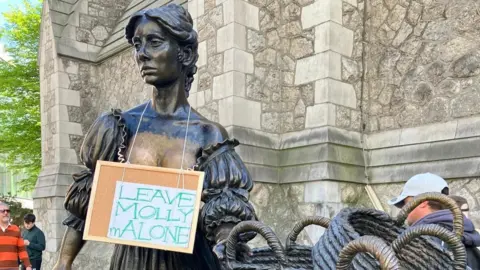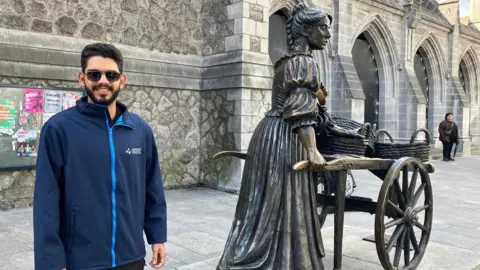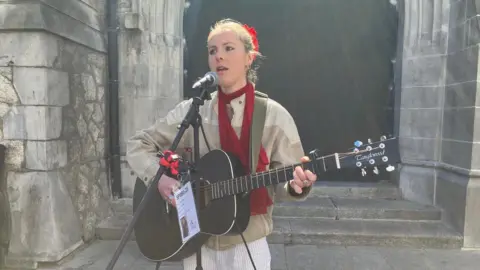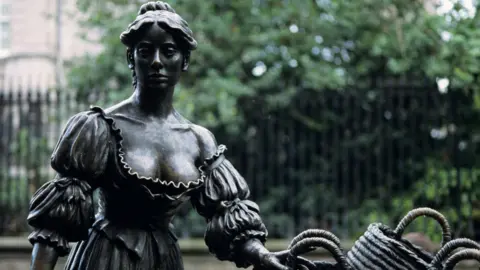Stewards brought in to protect 'groped' Molly Malone statue
 BBC
BBCStewards have been stationed next to the Molly Malone statue in Dublin to discourage people from touching it.
The city's council is running the pilot scheme after it received complaints about people groping the sculpture's breasts.
The practice is thought to have been started by a local tour guide, and the bronze has now become discoloured from years of touching.
Ray Yeates, the Arts Officer for Dublin City Council said stewards were in place to have a "conversation" with people about touching Molly Malone.

"They're not guards or police, it's a gentle confrontation of the behaviour," he said.
"Some people say, and they have a point to make, that it's being touched inappropriately," he told BBC News NI.
While he said it was a "worldwide phenomenon that statues are touched or rubbed and it becomes a custom," some people had "made a good point where we're mimicking behaviour we don't want to see in public".
"It would be illegal in public, so why would we mimic it?"
However, he added that, at the same time, "some people see no harm in this whatsoever and think it's a very trivial matter for council to be involved in".
'Thousands of Euro worth of damage'

"There is a question of damage because several thousand Euro of damage would be done every few months.
"This is damaging the statue and it is upsetting people."
Mr Yeates said other options such as moving the statue's location, raising it on a plinth or repairing it more regularly, were being considered.
The sculpture has been in Dublin since 1988 in tribute to a woman who sold shellfish on the streets of the Irish capital.
Over the years she's come to represent the city's working people and many believe, Molly Malone deserves more respect.
BBC News NI asked people on the streets of Dublin what they think.

Music activist Tilly Cripwell started the Leave Molly mAlone campaign last year.
"I spent loads of hours busking beside the Molly Malone statue and got more and more annoyed at hundreds of people touching the statue's breasts for good luck," she said.
"It's become what some people think is a tradition," she said.
"I'm bored of seeing this kind of misogynistic behaviour normalised in culture."
Tilly said she'd like to see the Molly Malone sculpture raised on a plinth, with a plaque denoting the history behind it.
"These are also examples we're setting to younger generations," she said.
"She needs respect so that she is awarded the honour she deserves by being such an iconic woman in Irish culture."
As the stewards were on duty, she placed a sign bearing her campaign name around the neck of the Molly Malone statue while setting up for a busking slot, but it was quickly removed by a passer-by.

"For years people have been coming here and what they're doing is groping Molly's breasts," said Dublin resident Clodagh Keating.
"It was normalised, people thought it was okay and now we've said just because something is normal in society, doesn't mean it's right."
'Just a tradition'

Among the tourists who spoke to the BBC, opinions were mixed.
One visitor from New Jersey told the BBC: "I can see the vulgarity of it but it's just a tradition, it's just what you do, so you do it.”
Another added: "It's fine. You're not taking her clothes off, you're touching an area of her body that's beloved."

Cala, from Minnesota, said: "I think it's pretty rude that it's obviously been rubbed clear in one area."
Seth, also from Minnesota, said: "It's not the most respectful way to treat an historical figure."

The stewards are in place at the Molly Malone statue until the end of this week only, at a cost of €350 (£298) per day, per steward.
Dublin City council says raising the sculpture on a plinth could cost upwards of €100,000 (£85,000), but that it is considering several options.
Who was Molly Malone?
 Andy Sotiriou/Getty Images
Andy Sotiriou/Getty ImagesThe Molly Malone statue was erected 37 years ago in tribute to a legendary Dublin woman who sold shellfish in the streets of the Irish capital.
It is not clear if the character is based on a real or fictional person, but the figure of Molly Malone has come to represent part of Dublin's working class community.
She was also the subject of a traditional folk song, which tells the story of a fishmonger's daughter who sold cockles and mussels from a wheelbarrow.
According to the colourful lyrics, Molly died of a fever but then returned as a ghost, still wheeling her wheelbarrow through the city's streets.
Many public artworks in Dublin are popularly referred to by rhyming nicknames, and for years the Molly Malone statue was known as "the tart with the cart".
This name was in part due to suggestions that Molly Malone worked as a fishmonger by day and as a sex worker by night.
The statue was first erected in Dublin's Grafton Street in 1988, created by the renowned bronze sculptor Jeanne Rynhart.
It was later moved to nearby St Andrews' Street to accommodate the construction of a tram line.
